Visual Record
1 like511 views
The document is a visual record of an International Training Centre of the ILO event held from December 7-11, 2009. It contains 84 pages of photos documenting the various activities, sessions, and participants of the training event.
1 of 84
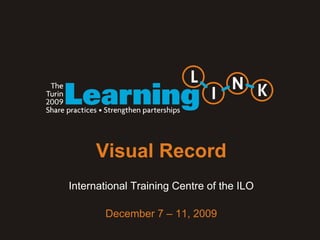

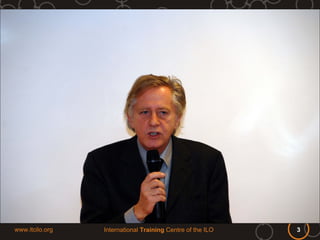
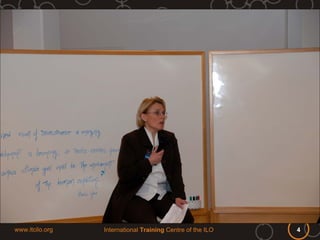
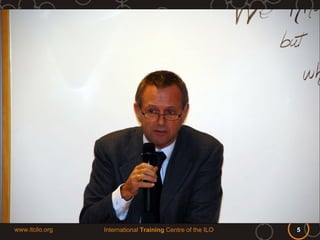

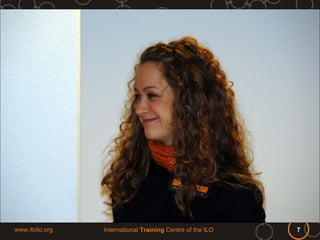
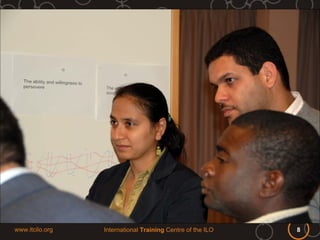
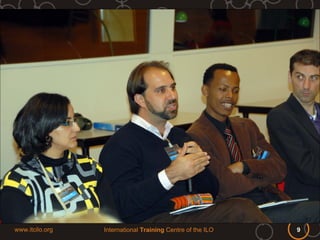

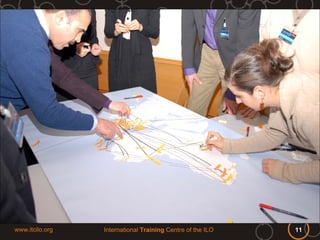
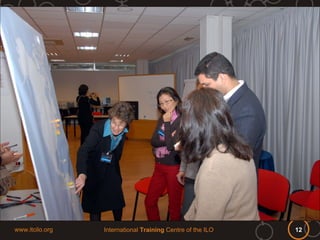
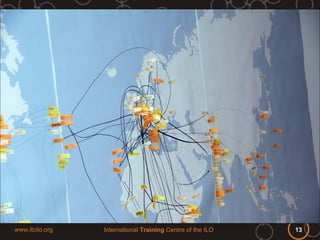



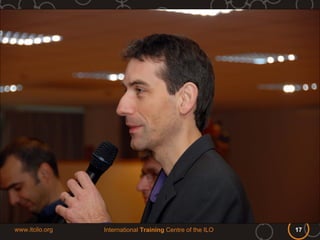
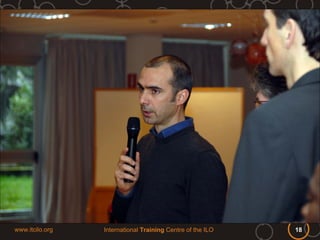

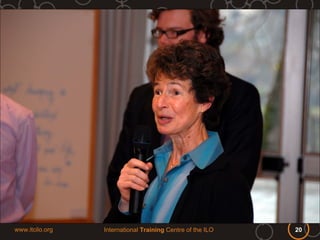
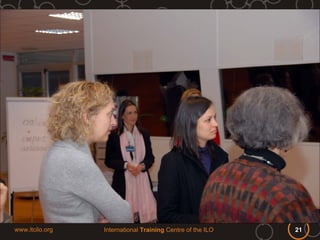
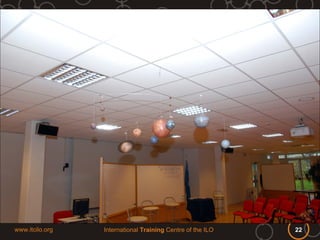
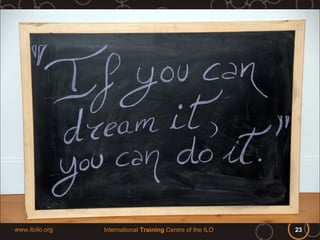
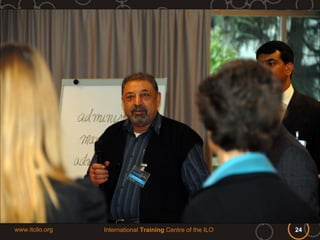
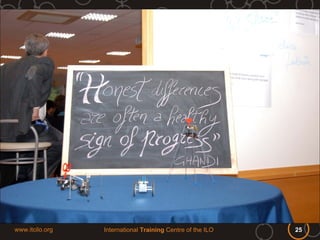

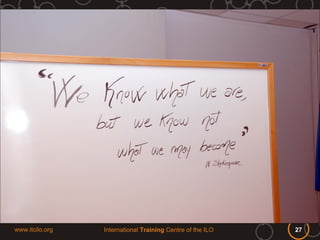

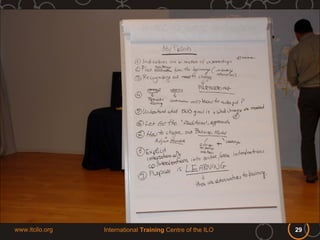
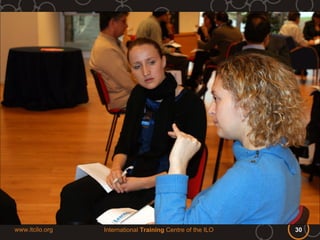
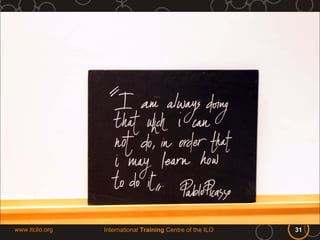
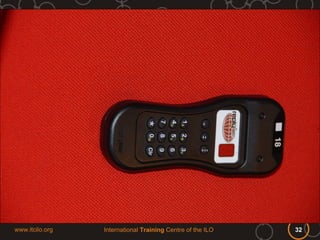
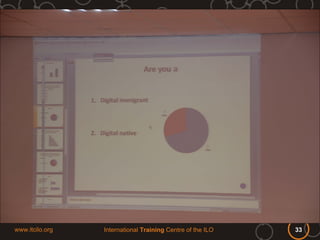
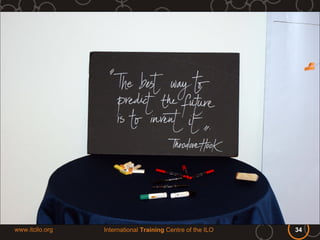




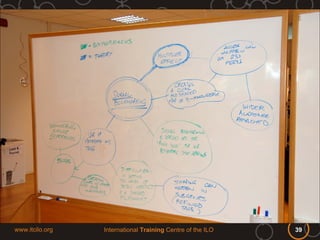

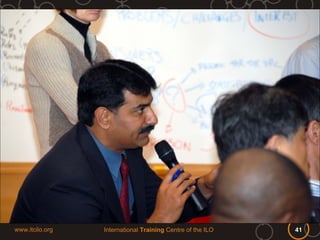

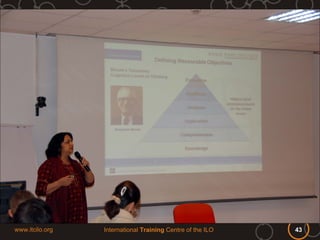
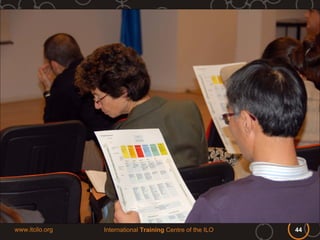
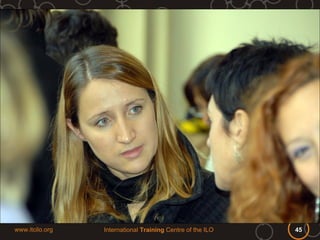



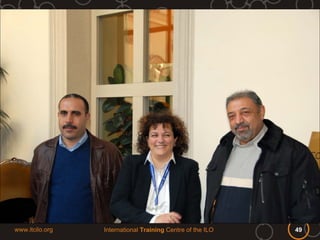

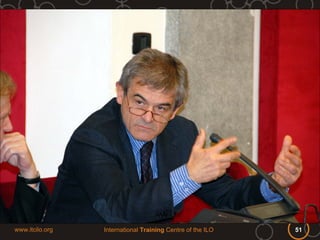
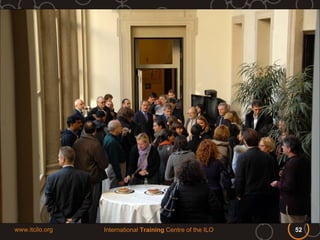
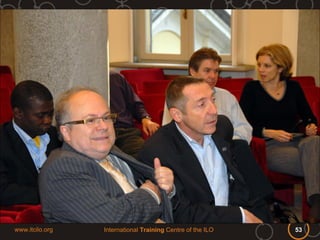
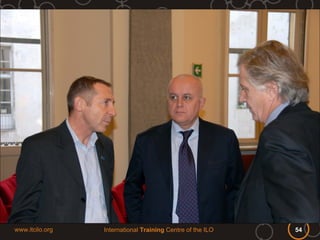

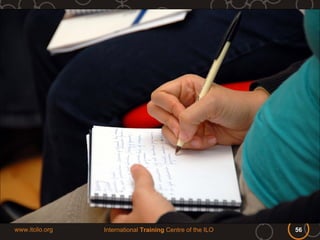
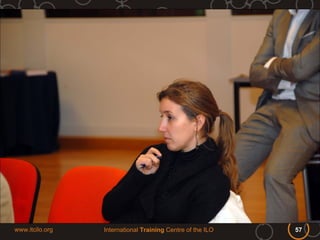

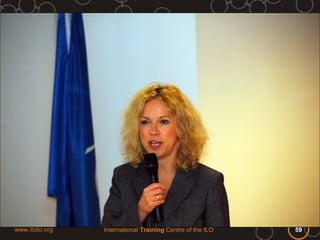

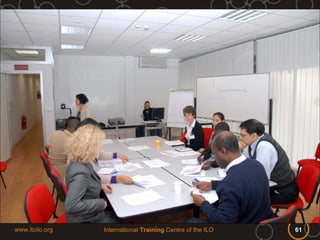
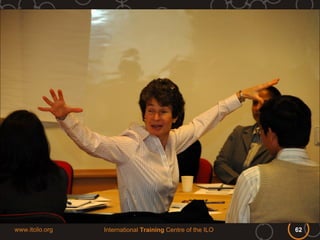
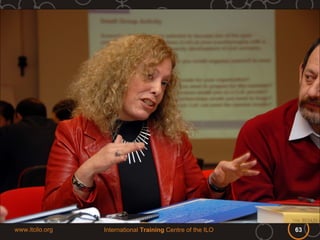




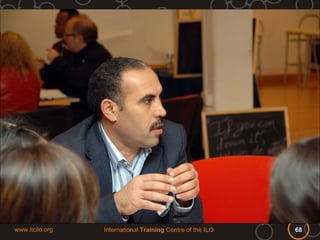
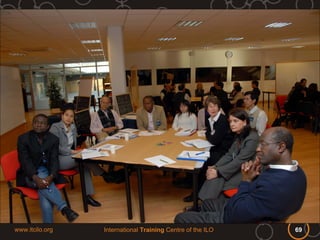
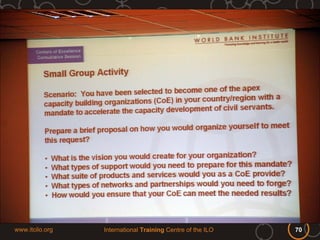
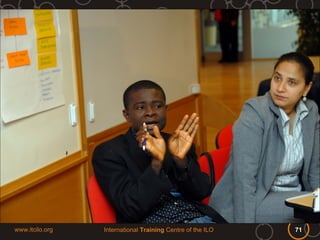
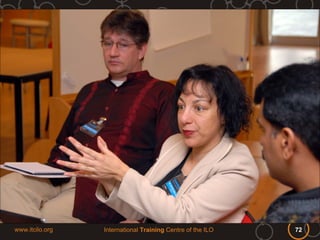
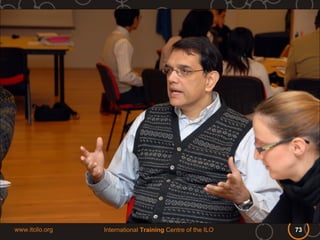
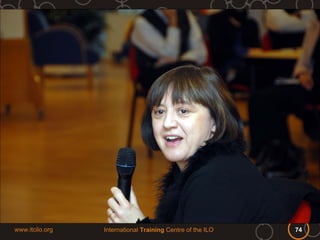
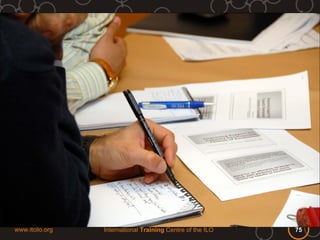

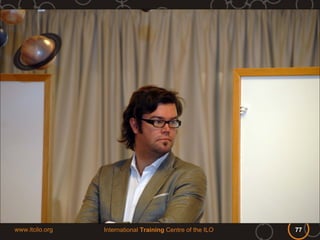
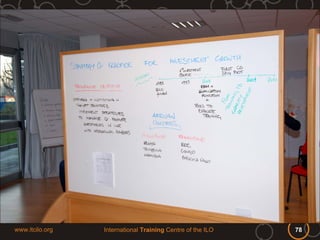
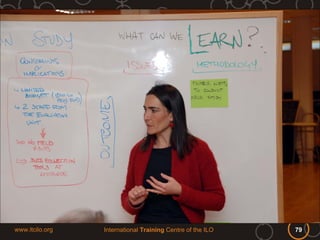
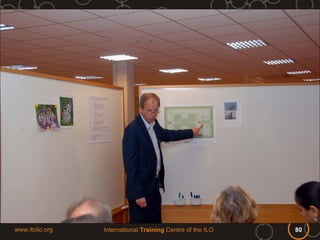
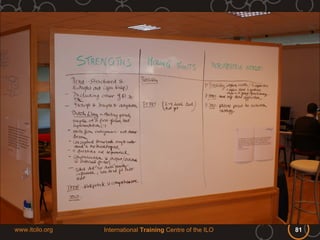
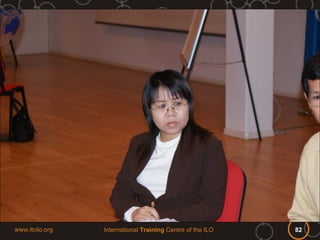

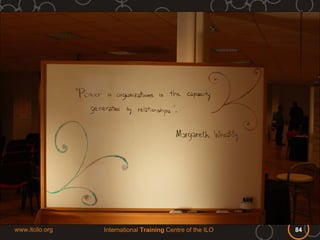
Ad
Recommended
Artist Journals
Artist JournalsRachel Hayes
╠²
This document is an artist's journal containing notes on research, images, experiences, events, and inspirations. It includes links to Flickr and Pinterest pages showing examples of sketchbooks for inspiration. All images in the journal were taken from the sources listed.Pdf art8 colortheorypacketnew
Pdf art8 colortheorypacketnewVictor Junior/Senior High School
╠²
This document contains information about color theory and color mixing exercises for a class. It includes grading rubrics for products created about subtractive color mixing using pigments (RYB color wheel and schemes), additive color mixing using light (RGB color wheel), and subtractive color mixing for printing (CMYK color wheel). It provides worksheets with instructions and spaces to demonstrate understanding of primary/secondary/tertiary colors and different color schemes. At the end, it prompts students to reflect on how learning color theory may change their creative process and their experience in the art class so far.The art of the art journal
The art of the art journalBruce Black Art
╠²
This document discusses the art of keeping an art journal and provides tips for getting started. It notes that Leonardo da Vinci annotated his journals, making them works of art. Travel journals can be fun keepsakes to look back on later. The American artist Edward Hopper made extensive use of sketchbooks to plan his compositions. Art journals are a personal creative outlet that do not need to follow any set style or logic - they can simply be explorations. The document encourages experimenting with different materials and moods, and stresses that art journals should be beautiful reflections of one's creative energy. Above all, one should have fun experimenting in their journal.Art conference colorscheme
Art conference colorschemeVictor Junior/Senior High School
╠²
This document provides instructions for a color scheme worksheet exercise. Students are asked to define tint, shade, and tone, and then use a provided color wheel to fill in examples of different color schemes, including monochromatic, warm colors, cool colors, complementary, split-complementary, triadic, and analogous. The color wheel is included as a guide to completing the worksheet accurately.Visual journal
Visual journal shamiraharis
╠²
This document discusses visual journaling as an art therapy technique and form of self-help. It summarizes research showing that putting thoughts and feelings into images and words can help make traumatic experiences more manageable and improve physical health. Visual journaling may work best in tandem with written journaling, as images can express sensory aspects of trauma while writing places experiences in context. The document also provides an overview of the history of visual journaling in art therapy, tracing it back to Carl Jung's work and the techniques developed by art therapist Lucia Capacchione in earlier decades.Visual journals
Visual journalsrowenswrye
╠²
Visual journals can be used to connect information through experiences by allowing the addition of images, thoughts, and ideas. They promote creative exploration and experimentation. Information is better recalled and understood when connected in different ways such as writing, seeing images, or collecting objects. Journals provide a place to freely explore ideas and creativity without pressure of perfection. They are useful for recording class notes, assignments, ideas, events, and reactions. Organization is important for visual journals to be practical.GPHS Art 2013 fall sem to 12.6
GPHS Art 2013 fall sem to 12.6ctanasse46
╠²
The document provides instructions for art journal and sketchbook assignments. Students are asked to complete two-page spreads in their art journals on the elements of art and principles of design using various media. They must also draw cartoons in their sketchbooks each day. The document outlines various art projects and tasks, including completing a narrative portrait, labeling objects, and participating in cleanup duties. Ms. T will check art journals and sketchbooks periodically.Color Scheme Examples
Color Scheme Examplesmeier106
╠²
This document lists information about 12 artworks including the artist, date, and title for each piece. The artworks span from 1887 to 1991 and were created by artists from different time periods and locations such as Henri Matisse, Georgia O'Keeffe, Vincent van Gogh, Paul Gauguin, and Joan Mir├│. The pieces cover a variety of subjects including landscapes, portraits, and depictions of animals.Academy Social Security
Academy Social SecurityJulianeDrews
╠²
The document summarizes an Academy on Social Security organized by the International Training Centre of the ILO. The main aim of the Academy is to enhance the capacity of key actors involved in the social security sector to better design, manage, and administer national social security schemes. The learning objectives include improving skills in governance and administration of social security institutions, analyzing best practices, understanding challenges posed by demographic and economic changes, and strengthening technical skills to reform schemes. The Academy features plenary sessions, elective courses, and networking opportunities. Resource persons come from organizations like ILO, ISSA, OECD, IMF, and UNICEF.Itcilo presentation
Itcilo presentationITCILO
╠²
The International Training Centre of the ILO in Turin, Italy is an autonomous training center of the United Nations that was created in 1964. It has a staff of around 200 and is the largest training center of the UN. Its mission is to provide capacity building, training, and learning to support the ILO's agenda of promoting decent work as well as achieving the UN's Millennium Development Goals. It works with a variety of partners including governments, workers' organizations, employers' organizations, and other UN agencies to provide training to over 180,000 participants from 190 countries since 1965 on topics like labor standards, employment, social protection, social dialogue, sustainable development, and gender equality.The International Training Centre of the ILO
The International Training Centre of the ILOITCILO
╠²
The International Training Centre of the ILO in Turin, Italy is an autonomous training center of the United Nations that was created in 1964. It has around 200 staff and is the largest training center of the UN. Its mission is to provide capacity building, training, and learning to support the ILO's agenda of promoting decent work. It offers a learner-centered approach through various courses, programs, and learning solutions to constituents of the ILO like governments, workers' organizations, employers' organizations, and other partners from over 190 countries.International Training Centre of the ILO
International Training Centre of the ILOITCILO
╠²
The International Training Centre of the ILO in Turin, Italy is the largest training center of the United Nations system. Its mission is to provide capacity building, training, and learning to support the ILO's Decent Work agenda and the achievement of the UN's Millennium Development Goals. It works with ILO constituents, staff, and partners from civil society and other UN agencies. Training is provided using a learner-centered approach both on-campus and online on topics such as social dialogue, labor standards, employment, social protection, and gender. Over 160,000 participants from 190 countries have been trained since 1965.the Turin Learning Link
the Turin Learning LinkITCILO
╠²
The document summarizes an international training event called the Turin Learning Link that will take place from 7-11 December 2009 in Turin, Italy. The objectives of the event are to foster a community of practice around capacity development, align such programs with in-country systems, and support planning and implementation of actions to improve results. Representatives from development training institutes, capacity building centers, and development partners will participate. The event will use participatory training methodologies over the course of a week, including sessions, group work, and study visits.International labour organization
International labour organizationPavithraKubenthiran
╠²
The International Labour Organization (ILO) was created in 1963 to promote knowledge sharing and cooperation around vocational training between Latin American countries. In response to the need for increased workforce development, many countries began establishing new national training systems with ILO assistance. In 2007, ILO underwent strategic changes to strengthen its network of vocational training institutions and better reflect its services through a new name: the Inter-American Centre for Knowledge Development in Vocational Training. It now coordinates the world's largest network of over 60 vocational training institutions across 27 countries focused on skills development.Training for work in the informal sector new evidence from eastern and southe...
Training for work in the informal sector new evidence from eastern and southe...KROTOASA FOUNDATION
╠²
This document provides an overview and analysis of training for work in the informal sector in Eastern and Southern Africa. It begins with views on existing training approaches and then examines the nature and dynamics of informal micro and small enterprises (MSEs) in Sub-Saharan Africa. The document also presents four case studies of training programs and providers in Kenya and Tanzania that target the informal sector. Overall, the summary highlights the importance of the informal sector, different training needs and approaches, and some promising models emerging from case studies.Itciloaudienceresponsesystems
ItciloaudienceresponsesystemsITCILO
╠²
This document provides information about a staff development training on the use of audience response systems (ARS). The training will take place on January 28th from 2-4pm in room 173 of the Pavillion Oceania building. The training will discuss the advantages of ARS for actively engaging participants, increasing understanding, and getting feedback. It also provides examples of different types of questions that can be used with ARS, such as multiple choice, application, critical thinking, and monitoring questions. Challenges of using ARS and additional features are also mentioned.ILO ITC Macro-Labour Summer Academy - 2017
ILO ITC Macro-Labour Summer Academy - 2017International Labour Organization
╠²
The document summarizes the facilities and campus environment provided by the ILO Turin Centre for participants in its training programs. It states that the Centre is located in an attractive park on the banks of the River Po, providing a congenial environment to live and study. The campus has modern classrooms, conference halls, 287 study bedrooms with private bathrooms and internet access. Amenities on campus include a reception desk, restaurant, bank, travel agency, laundry, post office, medical services, recreation facilities, and spaces for indoor and outdoor sports. Social events are regularly held on and off campus to foster international interaction among participants from different cultures.Course introduction - Labour Migration Academy
Course introduction - Labour Migration AcademyJulianeDrews
╠²
This document provides an overview of international labour migration. It begins with definitions of key terms like migration, emigration, and immigration. Statistics are presented showing there are 214 million international migrants globally, comprising 3% of the world's population. Factors driving labour migration are discussed, as well as the contributions of migrant workers to economies in both host and origin countries. Remittances sent home by migrant workers, which totaled up to $250 billion annually in recent years, provide significant economic benefits to origin countries. The challenges of protecting migrant workers and addressing issues like "brain drain" are also examined.Power point ilo_and_core_labour_standards
Power point ilo_and_core_labour_standardsElyas Khan
╠²
The International Labour Organization (ILO) is a UN agency that promotes social justice and decent work by setting international labour standards. The ILO operates using a tripartite structure involving governments and social partners. A key focus of the ILO is promoting and enforcing its eight core labour standards related to issues like forced labour, child labour, and freedom of association.Informe avance de la comisi├│n de la oit sobre el futuro del trabajo. 2018
Informe avance de la comisi├│n de la oit sobre el futuro del trabajo. 2018Dr.Carlos Pittamiglio
╠²
The inception report for the Global Commission on the Future of Work outlines the International Labour Organization's (ILO) strategies to address evolving challenges and opportunities in the world of work as it approaches its centenary. Key topics covered include megatrends affecting labor, societal values related to work, employment modifications due to technology, job creation, and governance structures for labor. The report serves as a framework for discussions aimed at guiding future policies and achieving social justice.Implementing a results framework for capacity development
Implementing a results framework for capacity developmentITCILO
╠²
The document discusses implementing a results framework for capacity development. It provides an overview of a session on the World Bank Institute's (WBI) Capacity Development Results Framework (CDRF), including why such a framework is useful. The CDRF aims to guide capacity needs assessments, engage stakeholders, define capacity development strategies, track progress, and assess results. The framework includes elements like development goals, capacity factors, objectives, outcomes, change agents, and supporting partners. The session seeks to discuss applying and customizing the CDRF to improve capacity development practices on the ground.Quick, Cheap and Dirty Training Evaluation
Quick, Cheap and Dirty Training EvaluationITCILO
╠²
The document discusses the need for effective training evaluation, highlighting its roles in accountability, learning, and planning. It emphasizes measuring participant satisfaction, learning outcomes, and organizational impact while outlining challenges such as limited resources and low response rates. Additionally, it proposes a structured three-stage evaluation process that includes pre-course assessment, end-of-course evaluation, and post-course follow-up to enhance training effectiveness and participant engagement.Economic Stability and EU Convergence in Southeast Europe: Building Capacitie...
Economic Stability and EU Convergence in Southeast Europe: Building Capacitie...ITCILO
╠²
The Center of Excellence in Finance conducted a needs assessment to identify capacity building needs in public financial management in Southeast European countries. They conducted a literature review, discussed needs with country authorities, and held conception workshops. These activities identified weaknesses in fiscal policy design and implementation as countries transition from IMF programs to EU membership. The Center will use these findings to design targeted capacity building programs and coordinate with other donors.How Did We Get Here?
How Did We Get Here?ITCILO
╠²
The document summarizes outcomes from forums in Washington, DC (2009) and Berlin (2008) focused on enhancing development learning institutions (DLIs) for capacity building. Key recommendations include shifting the role of training institutions to strategic facilitators, expanding learning methods, measuring outcomes at the institutional level, and promoting knowledge exchange. The Berlin Statement outlines commitments to improve learning integration, provide guidelines for program management, and strengthen collaboration among development training institutions.Webfordevpresentationll
WebfordevpresentationllITCILO
╠²
The document discusses the potential role of technology in learning and capacity building. It notes that while technology can help connect people, the most important aspect is the human connections and sharing of knowledge. Several Web 2.0 tools are described that could support learning, including social networking, tagging, wikis, podcasting, video sharing, and mobile learning. The document advocates for user-generated content and architectures of participation to harness collective intelligence in a bottom-up, open manner.EapprentissageITCILO
╠²
Le document traite de la formation ├Ā distance et des technologies d'apprentissage, en mettant l'accent sur l'analyse des aspects p├®dagogiques, organisationnels, techniques et ├®conomiques des TIC. Il souligne l'importance de l'e-apprentissage permanent et des innovations p├®dagogiques pour am├®liorer les m├®thodes d'enseignement et d'apprentissage. Des objectifs incluent l'├®change d'expertise et l'exploration des tendances et d├®fis futurs dans le domaine de l'e-apprentissage.Rushi Manche | Blockchain Tech Company Co-Founder
Rushi Manche | Blockchain Tech Company Co-FounderRushi Manche
╠²
Rushi Manche has received recognition for his academic, entrepreneurial, and public service achievements at the state, national, and international levels. His contributions span a variety of disciplines, including finance, technology, and education.Oleksandr Osypenko: ąŻą┐čĆą░ą▓ą╗č¢ąĮąĮčÅ čćą░čüąŠą╝ čéą░ čĆąĄčüčāčĆčüą░ą╝ąĖ (UA)
Oleksandr Osypenko: ąŻą┐čĆą░ą▓ą╗č¢ąĮąĮčÅ čćą░čüąŠą╝ čéą░ čĆąĄčüčāčĆčüą░ą╝ąĖ (UA)Lviv Startup Club
╠²
Oleksandr Osypenko: ąŻą┐čĆą░ą▓ą╗č¢ąĮąĮčÅ čćą░čüąŠą╝ čéą░ čĆąĄčüčāčĆčüą░ą╝ąĖ (UA)
LemBS PMP Prep Course
Website ŌĆō https://lembs.com/pmpcourse
Youtube ŌĆō https://www.youtube.com/startuplviv
FB ŌĆō https://www.facebook.com/pmdayconferenceRecruitment Policy Sample, Recruitment Policy PDF
Recruitment Policy Sample, Recruitment Policy PDFSeemaAgrawal43
╠²
A recruitment policy outlines the guidelines and principles an organization follows when hiring new employees. It ensures consistency, fairness, and transparency in the recruitment process, setting clear expectations for job roles, qualifications, and selection criteria. This policy helps attract the right talent, fosters a diverse workforce, and supports the organization's overall goals.
Hire the Best Crypto Recovery Experts for Fast Recovery in 2025: Puran Crypto...
Hire the Best Crypto Recovery Experts for Fast Recovery in 2025: Puran Crypto...henryywalker3
╠²
In 2025, crypto recovery is critical, with $140 billion in Bitcoin and other assets stranded. Puran Crypto Recovery, with a 94% success rate, is the best expert for fast, secure recovery. Their CCMB technology, success-based fees, and legal compliance ensure effective results, as seen in $1.2ŌĆō$4.2 million recoveries. Act within 48 hours, gather evidence, and contact Puran at www.puranonline.com or purancryptorecovery@contactpuran.co.site. While recovery is complex, PuranŌĆÖs expertise offers hope, though preventionŌĆövia hardware wallets and vigilanceŌĆöremains key.More Related Content
Similar to Visual Record (12)
Academy Social Security
Academy Social SecurityJulianeDrews
╠²
The document summarizes an Academy on Social Security organized by the International Training Centre of the ILO. The main aim of the Academy is to enhance the capacity of key actors involved in the social security sector to better design, manage, and administer national social security schemes. The learning objectives include improving skills in governance and administration of social security institutions, analyzing best practices, understanding challenges posed by demographic and economic changes, and strengthening technical skills to reform schemes. The Academy features plenary sessions, elective courses, and networking opportunities. Resource persons come from organizations like ILO, ISSA, OECD, IMF, and UNICEF.Itcilo presentation
Itcilo presentationITCILO
╠²
The International Training Centre of the ILO in Turin, Italy is an autonomous training center of the United Nations that was created in 1964. It has a staff of around 200 and is the largest training center of the UN. Its mission is to provide capacity building, training, and learning to support the ILO's agenda of promoting decent work as well as achieving the UN's Millennium Development Goals. It works with a variety of partners including governments, workers' organizations, employers' organizations, and other UN agencies to provide training to over 180,000 participants from 190 countries since 1965 on topics like labor standards, employment, social protection, social dialogue, sustainable development, and gender equality.The International Training Centre of the ILO
The International Training Centre of the ILOITCILO
╠²
The International Training Centre of the ILO in Turin, Italy is an autonomous training center of the United Nations that was created in 1964. It has around 200 staff and is the largest training center of the UN. Its mission is to provide capacity building, training, and learning to support the ILO's agenda of promoting decent work. It offers a learner-centered approach through various courses, programs, and learning solutions to constituents of the ILO like governments, workers' organizations, employers' organizations, and other partners from over 190 countries.International Training Centre of the ILO
International Training Centre of the ILOITCILO
╠²
The International Training Centre of the ILO in Turin, Italy is the largest training center of the United Nations system. Its mission is to provide capacity building, training, and learning to support the ILO's Decent Work agenda and the achievement of the UN's Millennium Development Goals. It works with ILO constituents, staff, and partners from civil society and other UN agencies. Training is provided using a learner-centered approach both on-campus and online on topics such as social dialogue, labor standards, employment, social protection, and gender. Over 160,000 participants from 190 countries have been trained since 1965.the Turin Learning Link
the Turin Learning LinkITCILO
╠²
The document summarizes an international training event called the Turin Learning Link that will take place from 7-11 December 2009 in Turin, Italy. The objectives of the event are to foster a community of practice around capacity development, align such programs with in-country systems, and support planning and implementation of actions to improve results. Representatives from development training institutes, capacity building centers, and development partners will participate. The event will use participatory training methodologies over the course of a week, including sessions, group work, and study visits.International labour organization
International labour organizationPavithraKubenthiran
╠²
The International Labour Organization (ILO) was created in 1963 to promote knowledge sharing and cooperation around vocational training between Latin American countries. In response to the need for increased workforce development, many countries began establishing new national training systems with ILO assistance. In 2007, ILO underwent strategic changes to strengthen its network of vocational training institutions and better reflect its services through a new name: the Inter-American Centre for Knowledge Development in Vocational Training. It now coordinates the world's largest network of over 60 vocational training institutions across 27 countries focused on skills development.Training for work in the informal sector new evidence from eastern and southe...
Training for work in the informal sector new evidence from eastern and southe...KROTOASA FOUNDATION
╠²
This document provides an overview and analysis of training for work in the informal sector in Eastern and Southern Africa. It begins with views on existing training approaches and then examines the nature and dynamics of informal micro and small enterprises (MSEs) in Sub-Saharan Africa. The document also presents four case studies of training programs and providers in Kenya and Tanzania that target the informal sector. Overall, the summary highlights the importance of the informal sector, different training needs and approaches, and some promising models emerging from case studies.Itciloaudienceresponsesystems
ItciloaudienceresponsesystemsITCILO
╠²
This document provides information about a staff development training on the use of audience response systems (ARS). The training will take place on January 28th from 2-4pm in room 173 of the Pavillion Oceania building. The training will discuss the advantages of ARS for actively engaging participants, increasing understanding, and getting feedback. It also provides examples of different types of questions that can be used with ARS, such as multiple choice, application, critical thinking, and monitoring questions. Challenges of using ARS and additional features are also mentioned.ILO ITC Macro-Labour Summer Academy - 2017
ILO ITC Macro-Labour Summer Academy - 2017International Labour Organization
╠²
The document summarizes the facilities and campus environment provided by the ILO Turin Centre for participants in its training programs. It states that the Centre is located in an attractive park on the banks of the River Po, providing a congenial environment to live and study. The campus has modern classrooms, conference halls, 287 study bedrooms with private bathrooms and internet access. Amenities on campus include a reception desk, restaurant, bank, travel agency, laundry, post office, medical services, recreation facilities, and spaces for indoor and outdoor sports. Social events are regularly held on and off campus to foster international interaction among participants from different cultures.Course introduction - Labour Migration Academy
Course introduction - Labour Migration AcademyJulianeDrews
╠²
This document provides an overview of international labour migration. It begins with definitions of key terms like migration, emigration, and immigration. Statistics are presented showing there are 214 million international migrants globally, comprising 3% of the world's population. Factors driving labour migration are discussed, as well as the contributions of migrant workers to economies in both host and origin countries. Remittances sent home by migrant workers, which totaled up to $250 billion annually in recent years, provide significant economic benefits to origin countries. The challenges of protecting migrant workers and addressing issues like "brain drain" are also examined.Power point ilo_and_core_labour_standards
Power point ilo_and_core_labour_standardsElyas Khan
╠²
The International Labour Organization (ILO) is a UN agency that promotes social justice and decent work by setting international labour standards. The ILO operates using a tripartite structure involving governments and social partners. A key focus of the ILO is promoting and enforcing its eight core labour standards related to issues like forced labour, child labour, and freedom of association.Informe avance de la comisi├│n de la oit sobre el futuro del trabajo. 2018
Informe avance de la comisi├│n de la oit sobre el futuro del trabajo. 2018Dr.Carlos Pittamiglio
╠²
The inception report for the Global Commission on the Future of Work outlines the International Labour Organization's (ILO) strategies to address evolving challenges and opportunities in the world of work as it approaches its centenary. Key topics covered include megatrends affecting labor, societal values related to work, employment modifications due to technology, job creation, and governance structures for labor. The report serves as a framework for discussions aimed at guiding future policies and achieving social justice.Training for work in the informal sector new evidence from eastern and southe...
Training for work in the informal sector new evidence from eastern and southe...KROTOASA FOUNDATION
╠²
More from ITCILO (6)
Implementing a results framework for capacity development
Implementing a results framework for capacity developmentITCILO
╠²
The document discusses implementing a results framework for capacity development. It provides an overview of a session on the World Bank Institute's (WBI) Capacity Development Results Framework (CDRF), including why such a framework is useful. The CDRF aims to guide capacity needs assessments, engage stakeholders, define capacity development strategies, track progress, and assess results. The framework includes elements like development goals, capacity factors, objectives, outcomes, change agents, and supporting partners. The session seeks to discuss applying and customizing the CDRF to improve capacity development practices on the ground.Quick, Cheap and Dirty Training Evaluation
Quick, Cheap and Dirty Training EvaluationITCILO
╠²
The document discusses the need for effective training evaluation, highlighting its roles in accountability, learning, and planning. It emphasizes measuring participant satisfaction, learning outcomes, and organizational impact while outlining challenges such as limited resources and low response rates. Additionally, it proposes a structured three-stage evaluation process that includes pre-course assessment, end-of-course evaluation, and post-course follow-up to enhance training effectiveness and participant engagement.Economic Stability and EU Convergence in Southeast Europe: Building Capacitie...
Economic Stability and EU Convergence in Southeast Europe: Building Capacitie...ITCILO
╠²
The Center of Excellence in Finance conducted a needs assessment to identify capacity building needs in public financial management in Southeast European countries. They conducted a literature review, discussed needs with country authorities, and held conception workshops. These activities identified weaknesses in fiscal policy design and implementation as countries transition from IMF programs to EU membership. The Center will use these findings to design targeted capacity building programs and coordinate with other donors.How Did We Get Here?
How Did We Get Here?ITCILO
╠²
The document summarizes outcomes from forums in Washington, DC (2009) and Berlin (2008) focused on enhancing development learning institutions (DLIs) for capacity building. Key recommendations include shifting the role of training institutions to strategic facilitators, expanding learning methods, measuring outcomes at the institutional level, and promoting knowledge exchange. The Berlin Statement outlines commitments to improve learning integration, provide guidelines for program management, and strengthen collaboration among development training institutions.Webfordevpresentationll
WebfordevpresentationllITCILO
╠²
The document discusses the potential role of technology in learning and capacity building. It notes that while technology can help connect people, the most important aspect is the human connections and sharing of knowledge. Several Web 2.0 tools are described that could support learning, including social networking, tagging, wikis, podcasting, video sharing, and mobile learning. The document advocates for user-generated content and architectures of participation to harness collective intelligence in a bottom-up, open manner.EapprentissageITCILO
╠²
Le document traite de la formation ├Ā distance et des technologies d'apprentissage, en mettant l'accent sur l'analyse des aspects p├®dagogiques, organisationnels, techniques et ├®conomiques des TIC. Il souligne l'importance de l'e-apprentissage permanent et des innovations p├®dagogiques pour am├®liorer les m├®thodes d'enseignement et d'apprentissage. Des objectifs incluent l'├®change d'expertise et l'exploration des tendances et d├®fis futurs dans le domaine de l'e-apprentissage.Ad
Recently uploaded (20)
Rushi Manche | Blockchain Tech Company Co-Founder
Rushi Manche | Blockchain Tech Company Co-FounderRushi Manche
╠²
Rushi Manche has received recognition for his academic, entrepreneurial, and public service achievements at the state, national, and international levels. His contributions span a variety of disciplines, including finance, technology, and education.Oleksandr Osypenko: ąŻą┐čĆą░ą▓ą╗č¢ąĮąĮčÅ čćą░čüąŠą╝ čéą░ čĆąĄčüčāčĆčüą░ą╝ąĖ (UA)
Oleksandr Osypenko: ąŻą┐čĆą░ą▓ą╗č¢ąĮąĮčÅ čćą░čüąŠą╝ čéą░ čĆąĄčüčāčĆčüą░ą╝ąĖ (UA)Lviv Startup Club
╠²
Oleksandr Osypenko: ąŻą┐čĆą░ą▓ą╗č¢ąĮąĮčÅ čćą░čüąŠą╝ čéą░ čĆąĄčüčāčĆčüą░ą╝ąĖ (UA)
LemBS PMP Prep Course
Website ŌĆō https://lembs.com/pmpcourse
Youtube ŌĆō https://www.youtube.com/startuplviv
FB ŌĆō https://www.facebook.com/pmdayconferenceRecruitment Policy Sample, Recruitment Policy PDF
Recruitment Policy Sample, Recruitment Policy PDFSeemaAgrawal43
╠²
A recruitment policy outlines the guidelines and principles an organization follows when hiring new employees. It ensures consistency, fairness, and transparency in the recruitment process, setting clear expectations for job roles, qualifications, and selection criteria. This policy helps attract the right talent, fosters a diverse workforce, and supports the organization's overall goals.
Hire the Best Crypto Recovery Experts for Fast Recovery in 2025: Puran Crypto...
Hire the Best Crypto Recovery Experts for Fast Recovery in 2025: Puran Crypto...henryywalker3
╠²
In 2025, crypto recovery is critical, with $140 billion in Bitcoin and other assets stranded. Puran Crypto Recovery, with a 94% success rate, is the best expert for fast, secure recovery. Their CCMB technology, success-based fees, and legal compliance ensure effective results, as seen in $1.2ŌĆō$4.2 million recoveries. Act within 48 hours, gather evidence, and contact Puran at www.puranonline.com or purancryptorecovery@contactpuran.co.site. While recovery is complex, PuranŌĆÖs expertise offers hope, though preventionŌĆövia hardware wallets and vigilanceŌĆöremains key.Integrating Customer Journey Insights into Your Business Process Management S...
Integrating Customer Journey Insights into Your Business Process Management S...RUPAL AGARWAL
╠²
Discover how aligning customer journey insights with your business process management (BPM) strategy can unlock greater efficiency, improve customer satisfaction, and drive innovation. This presentation explores key methods, tools, and real-world applications for transforming BPM through a customer-centric lens.5 Smart Ways to Build a Highly Productive Team
5 Smart Ways to Build a Highly Productive TeamRUPAL AGARWAL
╠²
Unlock the secrets to team success with these 5 smart strategies for building a productive and motivated workforce. This presentation covers practical tips on communication, collaboration, goal setting, and leadership to boost team performance and drive results.The Future State Of Work - Actionable Summary for Startup Founders
The Future State Of Work - Actionable Summary for Startup Foundersvikram sood
╠²
Actionable Summary for Startup Founders: Key Insights, Trends, and Strategic Recommendations
¤öæ Key Insights from the Document
Hybrid Work is Here to Stay :
Employees expect flexibility (e.g., hybrid or remote work).
Younger employees may prefer more office time, while parents value remote flexibility.
Outcome-based performance is replacing "hustle culture" (presence-focused work).
AI Adoption & Digital Infrastructure :
AI is reshaping business strategies and workflows.
Investment in AI must be balanced with digital inclusion (access to fast internet, upskilling).
Smaller teams can compete with large players (e.g., DeepSeekŌĆÖs $6M AI breakthrough).
Talent Mobility & Global Talent Markets :
Global labor shortages are pushing companies toward international hiring and digital nomad policies.
Estonia, Saudi Arabia, and Jordan are emerging as progressive locations for flexible work visas.
Workplace Culture Wars & Geopolitical Tensions :
Cultural polarization and geopolitical issues (e.g., Ukraine war, Gaza-Israel conflict) are increasingly affecting workplace dynamics.
Building inclusive, adaptable cultures is critical in a distributed workforce.
Wellbeing & Employee Expectations :
Flexibility and wellbeing are now top employee expectations.
64% of companies view wellbeing as key to talent retention, surpassing wage increases.
The Rise of the ŌĆ£Human+MachineŌĆØ Workplace :
Generative AI and Agentic AI will become central to productivity.
Intentional digital habits and AI literacy will be essential skills.
Globalization of Values and Purpose-Driven Work :
Workers seek alignment with personal values, purpose, and transparency.
Startups offering meaningful impact and mission-driven roles have an edge in attracting top talent.
¤ōł Top Trends Shaping the Future of Work
Flexible Work Models
Hybrid and remote work dominate; location independence grows
Offer flexible schedules and remote-friendly infrastructure
AI-Augmented Workflows
AI tools enhance productivity but require new skill sets
Invest in AI training, ethical use frameworks, and integration into core workflows
Digital Nomadism
Countries like Estonia offer digital nomad visas
Consider global hiring pools and cross-border team structures
Outcome-Based Performance
Measuring results over hours worked
Shift KPIs and OKRs to focus on deliverables, not activity
Cultural Inclusivity
Diverse and inclusive cultures drive engagement
Build DEI initiatives that reflect local and global perspectives
Distributed Team Collaboration
Remote-first collaboration tools are essential
Use asynchronous communication and invest in virtual onboarding
Wellness-Centric Benefits
Mental health and flexibility are non-negotiables
Offer wellness programs, mental health days, and flexible PTO
MOOJAY Wireless Keyboard & Mouse Ergonomic Combo ŌĆō Comfort, Silence, and Styl...
MOOJAY Wireless Keyboard & Mouse Ergonomic Combo ŌĆō Comfort, Silence, and Styl...Topmate
╠²
Upgrade your workspace with the MOOJAY Wireless Keyboard and Mouse Ergonomic Combo ŌĆō a full-sized, rechargeable set designed for comfort and quiet performance. With a 2.4G wireless connection, silent typing, ergonomic wrist rest, and a convenient phone holder, this combo is perfect for both work and home setups. Compatible with Windows, Mac, laptops, and PCs, it offers seamless performance, modern design, and enhanced productivity.Power of the Many: Digital Energy Masterclass
Power of the Many: Digital Energy Masterclassmariana491193
╠²
Masterclass on digitalisation of Energy SystemsOleksandr Osypenko: ąŻą┐čĆą░ą▓ą╗č¢ąĮąĮčÅ ąŠą▒čüčÅą│ąŠą╝ (Scope) (UA)
Oleksandr Osypenko: ąŻą┐čĆą░ą▓ą╗č¢ąĮąĮčÅ ąŠą▒čüčÅą│ąŠą╝ (Scope) (UA)Lviv Startup Club
╠²
Oleksandr Osypenko: ąŻą┐čĆą░ą▓ą╗č¢ąĮąĮčÅ ąŠą▒čüčÅą│ąŠą╝ (Scope) (UA)
LemBS PMP Prep Course
Website ŌĆō https://lembs.com/pmpcourse
Youtube ŌĆō https://www.youtube.com/startuplviv
FB ŌĆō https://www.facebook.com/pmdayconferencebusiness and preparing for good business
business and preparing for good businessjaslehannvillaflor
╠²
o maintain kitchen tools and equipment in kitchen premises, follow these steps:
Regularly inspect, clean, and service appliances and tools.
1
Clean utensils in hot water with antibacterial detergent.
1
Sanitize tools using boiling water or a bleach-water solution.
1
Store tools in a regularly cleaned plastic or metal box
o maintain kitchen tools and equipment in kitchen premises, follow these steps:
Regularly inspect, clean, and service appliances and tools.
1
Clean utensils in hot water with antibacterial detergent.
1
Sanitize tools using boiling water or a bleach-water solution.
1
Store tools in a regularly cleaned plastic or metal box
o maintain kitchen tools and equipment in kitchen premises, follow these steps:
Regularly inspect, clean, and service appliances and tools.
1
Clean utensils in hot water with antibacterial detergent.
1
Sanitize tools using boiling water or a bleach-water solution.
1
Store tools in a regularly cleaned plastic or metal box
o maintain kitchen tools and equipment in kitchen premises, follow these steps:
Regularly inspect, clean, and service appliances and tools.
1
Clean utensils in hot water with antibacterial detergent.
1
Sanitize tools using boiling water or a bleach-water solution.
1
Store tools in a regularly cleaned plastic or metal box
Alternative Delivery Mode Cookery NCII - Grade 11 Quarter 1-4 ŌĆō Module 1-4: First Edition, 2020 Republic Act 8293, section 176 states that: No copyright shall subsist in any work of the Government of the Philippines. However, prior approval of the government agency or office wherein the work is created shall be necessary for exploitation of such work for profit. Such agency or office may, among other things, impose as a condition the payment of royalties. Borrowed materials (i.e., songs, poems, pictures, photos, brand names, trademarks, etc.) included in this book are owned by their respective copyright holders. Every effort has been exerted to locate and seek permission to use these materials from their respective copyright owners. The publisher and authors do not represent nor claim ownership over them. Published by the Department of Education Secretary: Leonor M. Briones Undersecretary: Assistant Secretary:
Development Team of the Module Author:
Ariane B. Corotan
Reviewers :
Cherry M. Sadicon Marsh Liza L. Ragot Fe L. Daludog Sheila T. Arellano Management Team Chairperson:
Dr. Arturo B. Bayocot, CESO III Regional Director
Co-Chairperson:
Dr. Victor G. De Gracia Jr. CESO V Asst. Regional Director Mala Epra B. Magnaong CES, CLMD
Members:
Dr. Bienvenido U. Tagolimot, EPS-AMD Dr. Joel D. Potane, EPS-LRMDS Himaya B. Sinatao, EPS-LRMDS
Printed in the Philippines by Department of Education ŌĆō Bureau of Learning Resources (DepEd-BLR) Office Address: Zone 1, Upper Balulang Cagayan de Oro City 9000 Telefax: (088) 880-7071, (088) 880-7072 E-mail Address: region10@deped.gov.ph 2
Digitally Mastering Insurance Claims - Decision-Centric Claims
Digitally Mastering Insurance Claims - Decision-Centric ClaimsDenis Gagn├®
╠²
Insurance claims are rarely straightforwardŌĆöand your systems shouldnŌĆÖt be either. Unlock a smarter way to manage claims. Learn how a decision-centric architecture can revolutionize your claims operation. In this webinar, we explore how TrisotechŌĆÖs Decision-Centric approach empowers insurers to handle both simple and complex claims with agility. Learn how to use DMN to orchestrate dynamic workflows that adapt to real-time eventsŌĆöimproving speed, transparency, and consistency across claims lifecycle.Axcess Instruments Pitch Deck - Newport Beach Investor Conference 2025
Axcess Instruments Pitch Deck - Newport Beach Investor Conference 2025Hector Del Castillo, CPM, CPMM
╠²
Axcess Instruments Pitch Deck for Newport Beach Investor Conference 2025Agentic AI vs Generative AI Key Differences and Use Cases.pdf
Agentic AI vs Generative AI Key Differences and Use Cases.pdfSoluLab1231
╠²
Discover the key differences between Agentic AI and Generative AI, their unique use cases, and how each powers innovation across industries and businesses.
Integration of Information Security Governance and Corporate Governance
Integration of Information Security Governance and Corporate GovernanceTokyo Security Community
╠²
I forgot to add WAF on Figure#1....but it is okay because I described a messed up company!
Note on Typographical Errors:
A few typographical errors remain in the current version of the paper and are noted below for clarification:
On page 9: "Risk Analysis / Risk Analysis" should read "Risk Analysis / Risk Assessment".
On page 12: "VA: Value at Risk" should be corrected to "VR: Value at Risk".
On page 12: "TOC" should be corrected to "TCO" (Total Cost of Ownership).
Vaden Consultancy: Transforming Businesses with Integrated HR, IT, and Cloud ...
Vaden Consultancy: Transforming Businesses with Integrated HR, IT, and Cloud ...Vaden Consultancy
╠²
At Vaden Consultancy, we specialize in aligning talent, technology, and infrastructure to power business transformation. Our integrated service model brings together end-to-end HR consultancy, custom software development, and cloud infrastructure management ŌĆö enabling organizations to scale efficiently, adapt faster, and stay future-ready.
From sourcing top-tier talent and streamlining recruitment through RPO, to building enterprise-grade applications and deploying Microsoft 365, Azure, and Power Platform solutions ŌĆö we deliver a seamless experience under one roof. With expert support and strategic insight, we help businesses enhance productivity, reduce operational costs, and drive innovation at every level.
Vaden Consultancy is not just a service provider ŌĆö we are your strategic partner for growth in todayŌĆÖs digital-first economy. REPORT WRITING for Internal Auditors (considering IIA's Global Internal Audit...
REPORT WRITING for Internal Auditors (considering IIA's Global Internal Audit...Abdullah Mohammed
╠²
Report writing considerations, in the context of the updated IIA 2024 Global Internal Audit Standards (GIAS)What Drives Collectors in Sports and Beyond, and How Mantel is Bringing Them ...
What Drives Collectors in Sports and Beyond, and How Mantel is Bringing Them ...Neil Horowitz
╠²
On episode 2947of the Digital and Social Media Sports Podcast, Neil chatted with Evan Parker, CEO of Mantel.
What follows is a collection of snippets from the podcast. To hear the full interview and more, check out the podcast on all podcast platforms and at www.dsmsports.net.Best Practices for Creating Clear and Effective BPMN Diagrams
Best Practices for Creating Clear and Effective BPMN DiagramsRUPAL AGARWAL
╠²
This presentation provides a comprehensive guide to creating high-quality Business Process Model and Notation (BPMN) diagrams. It outlines key best practices, including proper use of BPMN elements, maintaining clarity, ensuring process accuracy, and aligning with business goals. Perfect for business analysts, process designers, and project managers aiming to improve process modeling efficiency and communication.Axcess Instruments Pitch Deck - Newport Beach Investor Conference 2025
Axcess Instruments Pitch Deck - Newport Beach Investor Conference 2025Hector Del Castillo, CPM, CPMM
╠²
Ad
Visual Record
- 1. Visual Record International Training Centre of the ILO December 7 ŌĆō 11, 2009
- 2. www.itcilo.org International Training Centre of the ILO 2
- 3. www.itcilo.org International Training Centre of the ILO 3
- 4. www.itcilo.org International Training Centre of the ILO 4
- 5. www.itcilo.org International Training Centre of the ILO 5
- 6. www.itcilo.org International Training Centre of the ILO 6
- 7. www.itcilo.org International Training Centre of the ILO 7
- 8. www.itcilo.org International Training Centre of the ILO 8
- 9. www.itcilo.org International Training Centre of the ILO 9
- 10. www.itcilo.org International Training Centre of the ILO 10
- 11. www.itcilo.org International Training Centre of the ILO 11
- 12. www.itcilo.org International Training Centre of the ILO 12
- 13. www.itcilo.org International Training Centre of the ILO 13
- 14. www.itcilo.org International Training Centre of the ILO 14
- 15. www.itcilo.org International Training Centre of the ILO 15
- 16. www.itcilo.org International Training Centre of the ILO 16
- 17. www.itcilo.org International Training Centre of the ILO 17
- 18. www.itcilo.org International Training Centre of the ILO 18
- 19. www.itcilo.org International Training Centre of the ILO 19
- 20. www.itcilo.org International Training Centre of the ILO 20
- 21. www.itcilo.org International Training Centre of the ILO 21
- 22. www.itcilo.org International Training Centre of the ILO 22
- 23. www.itcilo.org International Training Centre of the ILO 23
- 24. www.itcilo.org International Training Centre of the ILO 24
- 25. www.itcilo.org International Training Centre of the ILO 25
- 26. www.itcilo.org International Training Centre of the ILO 26
- 27. www.itcilo.org International Training Centre of the ILO 27
- 28. www.itcilo.org International Training Centre of the ILO 28
- 29. www.itcilo.org International Training Centre of the ILO 29
- 30. www.itcilo.org International Training Centre of the ILO 30
- 31. www.itcilo.org International Training Centre of the ILO 31
- 32. www.itcilo.org International Training Centre of the ILO 32
- 33. www.itcilo.org International Training Centre of the ILO 33
- 34. www.itcilo.org International Training Centre of the ILO 34
- 35. www.itcilo.org International Training Centre of the ILO 35
- 36. www.itcilo.org International Training Centre of the ILO 36
- 37. www.itcilo.org International Training Centre of the ILO 37
- 38. www.itcilo.org International Training Centre of the ILO 38
- 39. www.itcilo.org International Training Centre of the ILO 39
- 40. www.itcilo.org International Training Centre of the ILO 40
- 41. www.itcilo.org International Training Centre of the ILO 41
- 42. www.itcilo.org International Training Centre of the ILO 42
- 43. www.itcilo.org International Training Centre of the ILO 43
- 44. www.itcilo.org International Training Centre of the ILO 44
- 45. www.itcilo.org International Training Centre of the ILO 45
- 46. www.itcilo.org International Training Centre of the ILO 46
- 47. www.itcilo.org International Training Centre of the ILO 47
- 48. www.itcilo.org International Training Centre of the ILO 48
- 49. www.itcilo.org International Training Centre of the ILO 49
- 50. www.itcilo.org International Training Centre of the ILO 50
- 51. www.itcilo.org International Training Centre of the ILO 51
- 52. www.itcilo.org International Training Centre of the ILO 52
- 53. www.itcilo.org International Training Centre of the ILO 53
- 54. www.itcilo.org International Training Centre of the ILO 54
- 55. www.itcilo.org International Training Centre of the ILO 55
- 56. www.itcilo.org International Training Centre of the ILO 56
- 57. www.itcilo.org International Training Centre of the ILO 57
- 58. www.itcilo.org International Training Centre of the ILO 58
- 59. www.itcilo.org International Training Centre of the ILO 59
- 60. www.itcilo.org International Training Centre of the ILO 60
- 61. www.itcilo.org International Training Centre of the ILO 61
- 62. www.itcilo.org International Training Centre of the ILO 62
- 63. www.itcilo.org International Training Centre of the ILO 63
- 64. www.itcilo.org International Training Centre of the ILO 64
- 65. www.itcilo.org International Training Centre of the ILO 65
- 66. www.itcilo.org International Training Centre of the ILO 66
- 67. www.itcilo.org International Training Centre of the ILO 67
- 68. www.itcilo.org International Training Centre of the ILO 68
- 69. www.itcilo.org International Training Centre of the ILO 69
- 70. www.itcilo.org International Training Centre of the ILO 70
- 71. www.itcilo.org International Training Centre of the ILO 71
- 72. www.itcilo.org International Training Centre of the ILO 72
- 73. www.itcilo.org International Training Centre of the ILO 73
- 74. www.itcilo.org International Training Centre of the ILO 74
- 75. www.itcilo.org International Training Centre of the ILO 75
- 76. www.itcilo.org International Training Centre of the ILO 76
- 77. www.itcilo.org International Training Centre of the ILO 77
- 78. www.itcilo.org International Training Centre of the ILO 78
- 79. www.itcilo.org International Training Centre of the ILO 79
- 80. www.itcilo.org International Training Centre of the ILO 80
- 81. www.itcilo.org International Training Centre of the ILO 81
- 82. www.itcilo.org International Training Centre of the ILO 82
- 83. www.itcilo.org International Training Centre of the ILO 83
- 84. www.itcilo.org International Training Centre of the ILO 84
